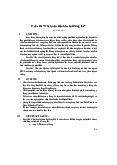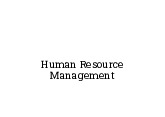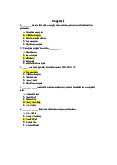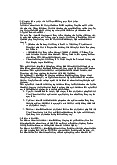





Preview text:
HRM 22.2A REVISION CONTENT Exam structure
1. 28 multiple choice questions (7 marks);
2. One theory question (1 mark); 3. One case analysis (2 marks)
Time: 90 minutes (closed book) Main points:
For multiple choice questions:
Chapter 1 Managing Human Resource Today - What is HR Management?
Chapter 4 Job Analysis and Talent Management - The basis of Job Analysis -
Method of Collecting Job Analysis information -
Writing Job Descriptions & Job Specifications
Chapter 5 Personal Planning and Recruiting -
Workforce planning & forecasting/ forecasting methods -
Internal & Outsides source of candidates
Chapter 6 Selecting Employees - Types of tests
- Interviewing candidates (structure, types of questions, how to administer, common interviewing mistakes)
Chapter 7 Training and Developing Employees
- Orienting/Onboarding New Employees
- Overview of the Training Process - Training methods
Chapter 8 Performance Management & Appraisal -
Basis concepts in Performance Appraisal -
Appraisal Methods (graphic rating scale, alternation ranking, paired comparison,
forced distribution, behaviorally anchored rating scale – BARS)
Chapter 10 Developing Compensation Plan -
The Basic Factors in Determining Pay Rates - Job evaluation method
Chapter 11 Pay for Performance and Employee Benefits - Individual Incentive Plans -
Organizational-wide incentive plans
Chapter 12 Maintaining Positive Employee Relations
- Employee Relations Programs for Building and Maintaining Positive Employee Relations
These programs include employee fair treatment programs, programs for
improving employee relations through improved communications, employee
recognition/relations programs, employee involvement programs, and having fair and
predictable disciplinary procedures.
Fair Treatment reflects concrete actions, such as “employees are treated with
respect,” and “employees are treated fairly.”
For essay and case studies:
1. Distinguish between Job Description & Job specification. Provide examples of
JD & JS for positions such as: a secretary, a receptionist, a sales
representative, a waiter,…
Job Descriptions: a list of a job’s duties, responsibilities, reporting relationships, working
conditions, and supervisory responsibilities—one product of a job analysis.
Job Specifications: a list of a job’s “human requirements,” that is, the requisite
education, skills, personality, and so on—another product of a job analysis. Example?
2. What is Job Analysis? Explain methods for Collecting Job Analysis Information.
Job Analysis is the procedure for determining the duties and skill requirements of a job
and the kind of person who should be hired for it.
Methods for Collecting Job Analysis Information: - The Interview - Questionnaires - Observation - Participant Diary/Logs -
Quantitative Job Analysis Techniques: The Position Analysis Questionnaire (PAQ) - Electronic Job Analysis
3. What are sources of candidate (recruitment tools)? Describe them.
Internal sources of candidates: current employees or “hiring from within”.
External sources of candidates: -
Recruiting via the Internet - Advertising - Employment Agencies -
Offshoring and Outsourcing Jobs - Executive Recruiters -
Recruitment Process Outsourcers and On-Demand -
Recruiting Services (ODRS) - Campus Recruiting - Referral and Walk-Ins - Military Personnel
4. How many basic types of question that can be used in an interview? Provide
at least 02 examples for each type. Types of Questions -
Situational questions focus on the candidate’s ability to explain what his or her
behavior would be in a given situation. -
Behavioral questions: ask interviewees how they behaved in the past in some situation. -
Knowledge and background questions probe candidates’ job-related knowledge and experience. -
“Trick” questions (such as “What kind of animal would you be?”)
Provide at least 02 examples for each type.
5. What is employee orientation? Why do we need to provide orientation for employees?
Employee Orientation is a procedure for providing new employees with basic
background information about the firm.
Why orientates employees? - Make the
and at home and part of the team.
new employee feel welcome -
Make sure the new employee has the basic information to function effectively,
such as e-mail access, personnel policies and benefits, and expectations in terms of work behavior. -
Help the new employee understand the organization in a broad sense (its past,
present, culture, and strategies and vision of the future). -
Start socializing the person into the firm’s culture and ways of doing things.
6. What is performance appraisal? Why do we need to conduct performance
appraisal? Who should do the appraising?
Performance Appraisal is any procedure that involves (1) setting work standards; (2)
assessing the employee's actual performance relative to the standards; and (3) providing
feedback to the employee with the aim of motivating that person to eliminate
performance deficiencies or to continue the performance above par.
Why do we need to conduct performance appraisal? -
First, most employers still base pay, promotion, and retention decisions on the employee’s appraisal. -
Second, appraisals play a central role in performance management. -
Third, the appraisal lets you and the subordinate develop a plan for correcting
any deficiencies and to reinforce the things he or she does right. -
Fourth, appraisals should provide an opportunity to review and recalibrate the
employee’s career plans in light of his or her exhibited strengths and weaknesses. -
Finally, supervisors use appraisals to identify employees’ training and development needs.
Performance appraisals are conducted for several reasons: -
Eliminate performance deficiencies/ to continue performance above the bar. -
Assisting decision making in employees’ salary adjustments, merit raises, and incentive rewards. -
Assisting decision making in the promotions, demotions, transfers, terminations,
and even layoffs of employees. -
Identify employees’ training and development needs, and performance gap.
Who should do the appraising? -
Peer appraisals: appraisals by one’s peers—are popular. -
Rating committee: the employee’s immediate supervisor and three or four other supervisors. -
Some employers obtain Employees’ self-ratings: along with supervisors’ ratings. -
Many employers have Subordinates rate their managers, usually for
developmental rather than for pay purposes. -
360-degree feedback: the employer collects performance information all around
an employee—from supervisors, subordinates, peers, and internal or external customers
—generally for developmental rather than pay purposes. - Crowd Appraisals
7. Practise using appraisal methods to appraise your HRM-team-members
performance (graphic rating scale, alternation ranking, paired comparison,
forced distribution, behaviorally anchored rating scale). … (class activity)
8. What is employee compensation? Compare direct financial payment and
indirect financial payment, examples?
Employee Compensation are all forms of pay or rewards going to employees and arising from their employment. -
Direct financial payments: pay in the form of wages, salaries, incentives,
commissions, and bonuses. -
Indirect financial payments: pay in the form of financial benefits such as insurance.
9. How many types of equity in determining pay rate? What are they? -
External equity refers to how a job’s pay rate in one company compares to the
job’s pay rate in other companies. -
Internal equity refers to how fair a particular job’s pay rate is when compared to
other jobs within the same company. -
Individual equity refers to the fairness of an individual’s pay as compared with
what his or her coworkers are earning for the same or very similar jobs within the
company, based on performance. -
Procedural equity refers to the “perceived fairness of the processes and
procedures used to make decisions regarding the allocation of pay.”
NOTE: Case study questions involves mostly knowledge in chapter 4,5,6.
Chapter 4: Job Analysis and Talent Management
Chapter 5: Personal Planning and Recruiting
Chapter 6: Selecting Employees




